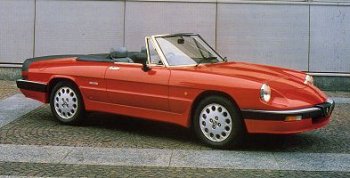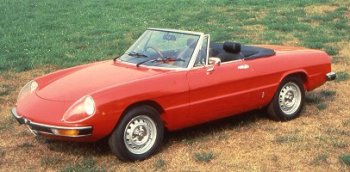|
Italiaspeed Book Review: Alfa Romeo Giulia Spider-The Essential Buyers Guide -
by Keith Booker
and Jim Talbott
Buying a classic
car is an expensive business and mistakes can prove costly
financially and in time, effort and stress. Wouldn’t it be
great if you could take an expert with you? With the aid of the Alfa Romeo Giulia
Spider-The Essential Buyers Guide offering a
step-by-step guidance from a marque specialist, you can!
You’ll discover all you need to know about the car you want
to buy. The unique points system will help you to place the
car's value in relation to condition, whilst extensive
photographs illustrate the problems to look out for.
The following paragraphs are excerpts from several chapters
taken from
Alfa Romeo
Giulia Spider - The Essential Buyers Guide:
Chapter 3: Living with a Giulia Spider - will
you get along?
Good Points: With its timeless Pininfarina styling,
an Alfa Romeo Spider is a visual delight. It is one of the
world’s most admired, two seat open sports cars, as popular
today as when it was in production. Within twenty-eight
years of manufacture there should be a model to suit
everyone. If you’re looking for a classic to pamper and use
on hot, sunny days, the elegant, long-tailed Spiders from
the late 1960s/early 70s may be for you; a Series 3 or 4
will meet the needs of someone who wants to use the car more
often, perhaps everyday; the 1750 and 2000 Kamm tails are a
good compromise between the two.
With a well-proven, all-aluminium, twin cam engine, five
speed gearbox, all round disc brakes, double wishbone front
and well located rear suspension, combined with precise
steering and excellent throttle response, a good Spider is a
pleasure to drive. Like most Alfas, the harder you push a
Spider, the better it rides and responds. With an easy to
use soft top and an excellent heater, an owner can enjoy
open air motoring throughout the year. It’s a comfortable
car for two people and their luggage and, whilst the driving
position will not suit everyone, most soon adapt to it. A
Spider’s major mechanical components are robust, if properly
maintained, and an excellent network of specialists provides
support.
Bad Points: Compared to its more ‘agricultural’
contemporaries, a Spider – with its advanced specification – will have required greater care and attention over the
years. In many cases it will not have received this, and so
suffered neglect and abuse. It is important, therefore, to
exercise caution when buying one and ensure that you
continue to look after it properly. A local garage may not
be able to help with this, so you will need to make a little
extra effort to keep it up to scratch.
Compared to modern cars, the gearbox will feel notchy and
slow when starting from cold, especially if the second gear
syncromesh is worn. The steering, on non-power assisted
models, will feel heavy when manoeuvring and in traffic.
This, combined with awkward pedal angles on some models,
will make slow driving hard going. In such conditions,
Spiders fitted with carburettors, will often ‘oil’ their
plugs, requiring a burst of high revs to clear.
Chapter 4: Relative Values - which model for you?
The Spider enjoyed a production life of twenty-eight years,
more than twice that of the Giulia GT coupé, with which it
shared much of its running gear. During this time it
underwent many changes; some more desirable than others.
Cars exported to the USA – although looking similar to those
sold in other markets – differ significantly, which can
affect their value outside that country. Only the 1600
Duetto and Series 4 models have similar specifications for
both markets. (See Chapter 12 for value assessment and
Chapter 16 Vital statistics for more information.)
Listed below, in percentage terms, are the relative values
of individual models in relation to the United Kingdom
market. Local markets may differ considerably. (Note: From
1975 (US and 1.6 from 1972) all models have a 115 model
designation, except RHD cars which remained as 105 series
until production ceased in 1977. US cars did not have
headlamp cowls but broad rimmed chrome headlamp bezels
instead.)
1600 Spider Duetto-1570cc. Made in RHD/LHD. Long,
rounded tail. Exported to the USA in small numbers. 1966-67:
100%
1750 Spider Veloce-1779cc. Made in RHD/LHD. Similar
in appearance to Duetto. Exported to USA. 1967-69: 100%
1300 Spider Junior-1290cc. RHD/LHD. Visually similar
to Duetto but no headlamp cowls or bezels. Not exported to
USA.1968-69: 80%
1750 Spider Veloce Kamm tail-1779cc (subsequently known
as Series 2). Made in RHD/LHD. First short tail model
with increased windscreen rake. Continued in various styles,
on subsequent versions. Exported to USA. 1970-71: 90%
|
 |
Within twenty-eight years of manufacture there
should be an Alfa Romeo Spider to suit everyone. If
you’re looking for a classic to pamper and use on
hot, sunny days, the elegant, long-tailed Spiders
from the late 1960s and early 70s may be for you; a
Series 3 or 4 will meet the needs of someone who
wants to use the car more often, perhaps even
everyday; while the 1750 and 2000 Kamm tails are a
good compromise between the two. |
|
|
 |
With its timeless Pininfarina styling, an Alfa Romeo
Spider is a visual delight. It is one of the world’s
most admired, two seat open sports cars, as popular
today as when it was in production. |
|
|
1300 Spider
Junior Kamm tail-1290cc. LHD only. Similar in appearance
to 1750 but no headlamp cowls or bezels. Not available in
USA. 1970-77: 60%
1600 Spider Junior/1600 Spider Veloce Kamm tail-1570cc.
LHD only. Appearance as 1300, SV as 2000. Not exported to
USA. 1972-81: 65%
2000 Spider Veloce Kamm tail-1962cc. Made in RHD/LHD.
Similar to 1750. RHD manufacture ceased in 1977. Exported to
USA where cars have extended chrome bumpers and overriders,
changing to prominent rubber bumpers with a token Alfa
shield from 1975. US limited editions: Niki Lauda and
Enthusiast's models. 1971-82: 90%
2000 Spider Series 3 (Aerodinamica)-1962cc. LHD only
(RHD cars converted). Euro cars without headlamp cowls but
broad bezels. Plastic front and rear bumpers/coloured coded
front and rear large black rear spoiler. Exported to the US.
Lower spec US limited edition was called the 'Graduate'.
1983-89: 65%
1600 Spider Series 3-1570cc. LHD only (RHD cars
converted). Appearance as per 2000. Not exported to US.
1983-89: 60%
2000 QV Green Cloverleaf Series 3-1962cc. LHD only (RHD
cars converted) Exported to US. As per Series 3 but fitted
with colour coded body kit. 1986-89: 70%
2000 Spider Veloce Series 4-1962cc. LHD only (RHD
cars converted). Complete restyle with integrated body
coloured bumpers/grille/side skirts, kicked up boot/trunk
lid and wrap around rear lights. Two-tone 'Beaute' and US
'CE' special editions. 1990-93: 80%
1.6 Spider Series 4-1570cc. LHD only. Offered in some
European countries. Similar appearance to 2000. 1990-92: 75%
Chapter 9:
Serious Evaluation - 60 minutes for years of enjoyment
(excerpts)
Gearlever
(gearshift) gaiter (boot): Both parts of the gearlever
gaiter – the outer leather/PVC item, and the rubber inner
part – are prone to splitting, allowing gearbox and road
noise, and engine fumes into the cabin. Replacements for
both are available. Various styles of gear knob were fitted
during the Spider’s production.
Seats: Spiders were fitted with several styles of PVC
or leather seats. Early cars had vertical pleating; later
ones horizontal. Green Cloverleafs/ Series 4s had their own
style. Token ‘rear seats’ changed to a shelf from 1979.
Check that the seats are correct for the car as this can
affect value. Headrests were fitted in most markets from
1968. Seats are prone to splitting along the stitching, and
the foam diaphragm of the base can compress. Excellent
retrims are available from specialists, but can be
expensive. Fragile seat back hinges and frames crack easily.
Check seats slide on their runners: if rusty, this can point
to problems underneath.
Carpets: Embossed rubber matting was fitted until
1977 and then various types of carpet. Green Cloverleafs
have red, Series 4s beige or black carpet, prone to rapid
deterioration, particularly in the oversill area. Good
quality replacements are available. New rubber sets are
expensive.
Door cards and door locks: Various styles have been
fitted. Warped cards are usually a result of missing or torn
door gaskets, resulting in the backing rotting and water
ingress. Are the armrests secure and/or split? Replacements
are available, but check availability and cost. Check
function of door locks, both inside and out. Replacements
are obtainable from specialists.
Door handles: Long tailed Spiders and Kamm tailed
Juniors have push button handles. Flush fitting,
teardrop-shaped items were fitted to subsequent models.
These are hinged at the rear, and if not adjusted correctly
can be difficult to operate. Later cars have rubber gaskets
which give a better seal with the door skin. Handles are
made of poor quality metal and tend Seats can wear, too!
|
|
Alfa Romeo Giulia
Spider-The Essential Buyers Guide - by
Keith Booker and Jim Talbott (Paperback. 64
pages. 195mm tall x 139mm. 100 colour photos).
Published by Veloce Publishing.
Tel: +44 (0)1305 260068, Fax: +44 (0)1305
268864, website:
www.veloce.co.uk,
E-mail:
info@veloce.co.uk |
|
|
 |
|
|
![]()
![]()